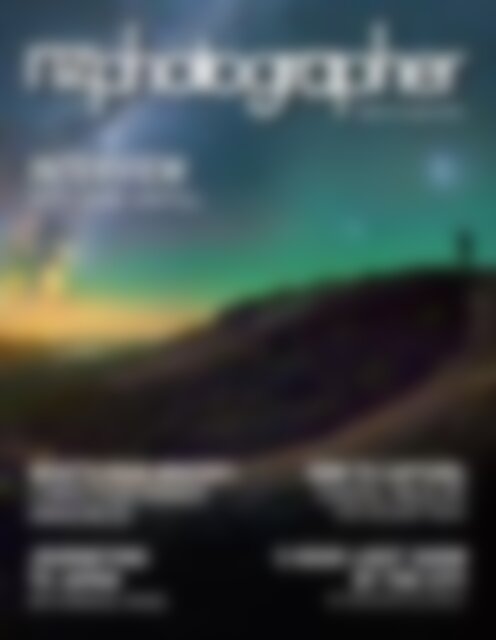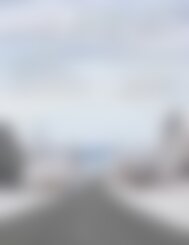NZPhotographer Issue 10, Aug 2018
As of December 2022, NZPhotographer magazine is only available when you purchase an annual or monthly subscription via the NZP website. Find out more: www.nzphotographer.nz
As of December 2022, NZPhotographer magazine is only available when you purchase an annual or monthly subscription via the NZP website. Find out more: www.nzphotographer.nz
Create successful ePaper yourself
Turn your PDF publications into a flip-book with our unique Google optimized e-Paper software.
ISSUE <strong>10</strong>, <strong>Aug</strong>ust <strong>2018</strong><br />
INTERVIEW<br />
WITH KANE HARTILL<br />
WHAT'S YOUR WINTER?<br />
COMPETITION WINNER<br />
ANNOUNCED<br />
JOURNEYING<br />
TO JAPAN<br />
WITH EMANUEL MAISEL<br />
HOW TO CAPTURE:<br />
COASTAL WILDLIFE<br />
WITH RICHARD YOUNG<br />
5 HOUR LIGHT SHOW<br />
BY THE CITY<br />
BY BRENDON GILCHRIST<br />
<strong>Aug</strong>ust <strong>2018</strong><br />
1
WELCOME TO ISSUE <strong>10</strong> OF<br />
NZ PHOTOGRAPHER MAGAZINE<br />
DEAR READERS,<br />
I hope Winter is treating you<br />
kindly and you've still been<br />
getting out there with your<br />
camera. If inspiration is a<br />
little lacking at the moment<br />
hopefully this issue will give<br />
you the boost you need!<br />
Among the following pages,<br />
you'll find a good dose of<br />
wildlife photography plus<br />
some travel inspiration both at<br />
home and abroad. Brendon<br />
shows us that we don't have<br />
to travel far to get new shots,<br />
whilst our returning guest<br />
contributor Emanuel Maisel<br />
takes us on a visual journey to<br />
Japan.<br />
Richard shows us how best to capture coastal wildlife in this issue<br />
whilst Charlie Dougherty's wildlife photography is sure to inspire you,<br />
and show that talent can come at any age. Whilst James is away,<br />
we welcome Ray back to the pages to discuss Prime vs Zoom lenses<br />
and we also get to know Kane Hartill in our interview.<br />
Whilst we've been busy preparing all of that, the entries have also<br />
been coming in for our 'What's Your Winter' photo competition. The<br />
winner is announced on page 69 along with a selection of the best<br />
entries – Is your photo included?<br />
Emily Goodwin<br />
Editor NZ Photographer<br />
General Info:<br />
<strong>NZPhotographer</strong> <strong>Issue</strong> <strong>10</strong><br />
<strong>Aug</strong>ust <strong>2018</strong><br />
Cover Photo<br />
by Kane Hartill<br />
www.kane9.myportfolio.com<br />
Publisher:<br />
Excio Group<br />
Website:<br />
www.excio.io/nzphotographer<br />
Group Director:<br />
Ana Lyubich<br />
ana@excio.io<br />
Editor:<br />
Emily Goodwin<br />
Graphic Design:<br />
Maksim Topyrkin<br />
Advertising Enquiries:<br />
Phone 04 889 29 25<br />
or Email hello@excio.io<br />
2 <strong>NZPhotographer</strong>
CONTRIBUTORS<br />
Ray Harness<br />
Ray is an amateur<br />
photographer who has<br />
dabbled in photography for<br />
45 years. He has a lot of<br />
pre-digital knowledge under<br />
his belt and enjoys capturing<br />
landscape scenes and<br />
animals.<br />
Brendon Gilchrist<br />
Brendon is the man behind<br />
ESB Photography. He treks<br />
from sea to mountain, and<br />
back again, capturing the<br />
uniqueness of New Zealand’s<br />
unforgiving landscape.<br />
Richard Young<br />
Richard is an award-winning<br />
landscape and wildlife<br />
photographer who teaches<br />
photography workshops and<br />
runs photography tours. He is<br />
the founder of New Zealand<br />
Photography Workshops.<br />
nzphotographer nzp_magazine nzp@excio.io<br />
© <strong>2018</strong> <strong>NZPhotographer</strong> Magazine<br />
All rights reserved. Reproduction of any material appearing in this magazine in<br />
any form is forbidden without prior consent of the publisher.<br />
Disclaimer:<br />
Opinions of contributing authors do not necessarily reflect the<br />
opinion of the magazine.<br />
<strong>Aug</strong>ust <strong>2018</strong><br />
3
CONTENTS<br />
6<br />
20<br />
6<br />
20<br />
24<br />
26<br />
32<br />
44<br />
66<br />
69<br />
INTERVIEW WITH KANE HARTILL<br />
INTERVIEW WITH KANE HARTILL<br />
HOW TO CAPTURE: COASTAL WILDLIFE<br />
by Richard Young<br />
BEHIND THE SHOT AT MILFORD SOUND<br />
with Kirsty Tamatea<br />
5 HOUR LIGHT SHOW BY THE CITY<br />
by Brendon Gilchrist<br />
RISING TALENT - GETTING TO KNOW<br />
CHARLIE DOUGHERTY<br />
JOURNEYING TO JAPAN<br />
by Emanuel Maisel<br />
PRIME LENSES VS ZOOM LENSES<br />
by Ray Harness<br />
WHAT'S YOUR WINTER?<br />
PHOTO COMPETITION<br />
44<br />
66<br />
HOW TO CAPTURE:<br />
COASTAL WILDLIFE<br />
JOURNEYING TO<br />
JAPAN<br />
32<br />
RISING TALENT - GETTING TO KNOW<br />
CHARLIE DOUGHERTY<br />
PRIME LENSES<br />
VS<br />
ZOOM LENSES
<strong>Aug</strong>ust <strong>2018</strong><br />
5
Interview with<br />
KANE HARTILL<br />
This month, we get to know the<br />
winner of our Wanaka Tree photo<br />
competition.<br />
KANE, WHAT’S YOUR STORY? IS<br />
PHOTOGRAPHY SOMETHING YOU’VE ALWAYS<br />
BEEN INTERESTED IN?<br />
Let me take you back in time to the moment when I<br />
turned just in time to watch my pack slowly tip off the<br />
ledge and tumble away into the darkness. Not my<br />
best gear management performance! But it was 2am<br />
on the descent of Mount Arrowsmith; we were just<br />
high school kids and we were tired out. Because the<br />
pack was open, my gear was scattered down 300m<br />
of Cameron glacier snowy rockyness. It took a while<br />
to locate the VHS-c video camera and Canon SLR I’d<br />
borrowed from my dad… both just wreckage... It was<br />
a great adventure but not an auspicious beginning to<br />
my photography hobby!<br />
After a year or so I bought another SLR camera and<br />
a couple of lenses and carried those weighty items all<br />
over the hills and crags of this fair island from the tip of<br />
Mount Cook to the shadowy lushness of Paynes Ford.<br />
Those years of exploration and risky adventures with<br />
fellow geology students were amazing and after each<br />
trip, I’d be chomping at the bit to get my boxes of<br />
Fujifilm Velvia slides back. At over one dollar per click<br />
and on a student budget, it definitely helped hone a<br />
keen sense of composition!<br />
I met my wife Steph and under subtle coercion mostly<br />
moved away from the risky alpine to concentrate<br />
more on rock climbing and snowboarding. We both<br />
swapped lens duties and enjoyed seeing our images<br />
6 <strong>NZPhotographer</strong><br />
and the odd ramble featured in magazines and<br />
guidebooks. To be honest, as the years went by it was<br />
increasingly Steph’s eye at the viewfinder with myself<br />
and friends on the sharp end.<br />
When the big Indian Ocean decadal switch occurred<br />
in the late nineties we gave up on Mt Olympus<br />
powder and started dabbling in a fringy sport I’d<br />
been trying since 1987 through my high school years;<br />
kiteboarding. It soon became an obsession and<br />
Steph and I were both swept up in the new sport.<br />
A whirlwind five years or so of mostly back-to-back<br />
summers as sponsored athletes on the world cup<br />
tour. Based in The Hague, between competitions and<br />
demos, we also worked in equipment development<br />
and did promotional video and photography.<br />
EXCITING TIMES! WHAT HAPPENED NEXT?<br />
One day in 2007, on the monotonous commute down<br />
gridlocked Blenheim road I realised I’d had enough<br />
of urban-ness and decided we should go bush.<br />
Luckily, after subtle coercion, Steph concurred so we<br />
sold up and bought an overgrown run down <strong>10</strong> acre<br />
organic farm up toward those Abel Tasman beaches<br />
and soon had a little guy accompanying us on our<br />
adventures.<br />
Family life, work, and renovations kept things simple for<br />
a long while… a phase of point and shoot cameras!<br />
I ended up attaching a waterproof compact to the<br />
leading edge of my kite for many missions. I would
MISTY FREQUENCIES<br />
F2.8, 15s, ISO6400<br />
set it on time lapse mode, one shot per 20 seconds,<br />
and then head out for hours exploring the golden<br />
sandy coastline by kiteboard, sometimes with my son<br />
onboard standing between my feet!<br />
In early 2015 I started pointing the compact camera<br />
and a GoPro upward attempting astro time-lapse but<br />
that didn’t last long! In 2015 I bought my first DSLR, a<br />
lightweight little Nikon D5300 body with a Tamron<br />
17-50mm F2.8 lens.<br />
By the end of that year, I had night shooting and<br />
stitching as dialed as could be with rudimentary<br />
gear and software and was itching for full frame.<br />
Pretty much everyone was shooting Canon 6D’s,<br />
and stomping on Nikon in online discussions, or so it<br />
seemed. But after seeing some noise tests and DR<br />
scores I diverged and got the Nikon D750 along with<br />
Samyang’s 24mm F1.4 and the Sigma art 50mm F1.4<br />
had me ready for any composition.<br />
HOW WOULD YOU DESCRIBE YOUR<br />
PHOTOGRAPHY STYLE?<br />
I think I tend toward aiming for moody vignetted<br />
scenes with a dramatic in-scene light source and<br />
some close foreground feature of interest. At least<br />
in my visualising and motivation that’s what I like if<br />
not overly manifested in my gallery yet! It’s a cliché<br />
formula yes, but likely for the reason that it optimises<br />
all elements in the frame for maximum impact. I used<br />
to be staunchly thirdly, framing landscape views but<br />
now if I glance across my online gallery I notice it has<br />
become quite centrist.<br />
WHAT HAVE BEEN YOUR PROUDEST MOMENTS<br />
IN PHOTOGRAPHY?<br />
My first trip with the new gear was a windy February<br />
night up at the Base of Farewell Spit. An image from<br />
that night, “Badlands” won third place on Gurushots<br />
and they used it as their social media promo image.<br />
Then there was a fantastic night out on the Abel<br />
Tasman coast. Firstly I remember quite nervously<br />
shooting a two row panoramic nightscape which<br />
spawned “Misty Frequencies”, a composition I’m<br />
really proud of which has been one of my most<br />
printed images… NikonNZ took a shine to it using it as<br />
their Facebook sponsored ad image for quite a while.<br />
I also caught "The Navigator" (next page) just before<br />
sunset, a tricky bracketed stitched pano which won<br />
the D-photo landscape photographer of the year<br />
2016.<br />
Next, I scored an epic night at the Tekapo Church<br />
on a full moon with a fast moving veil of stratus…<br />
perfect for single shot super wides. A couple of my<br />
long exposures from that night won a few Viewbug<br />
competitions - “New take on an overshot scene”<br />
theme etc. I was really lucky with the conditions<br />
making it easy to get something unique, but it did help<br />
to have a wide 14mm and a low rising point of view to<br />
accentuate and ‘radialise’ the cloud streaks.<br />
<strong>Aug</strong>ust <strong>2018</strong><br />
7
THE NAVIGATOR<br />
F8, 15s, ISO<strong>10</strong>0<br />
8 <strong>NZPhotographer</strong>
<strong>Aug</strong>ust <strong>2018</strong><br />
9
HALIG<br />
F5, 300s, ISO300<br />
<strong>10</strong> <strong>NZPhotographer</strong>
MIDNIGHT RUSH<br />
F3.5, 60s, ISO800<br />
<strong>Aug</strong>ust <strong>2018</strong><br />
11
IRON BORNE<br />
F2.8, 20s, ISO6400<br />
12 <strong>NZPhotographer</strong>
<strong>Aug</strong>ust <strong>2018</strong><br />
13
JOVIAN NIGHT<br />
F2.8, 20s, ISO6400<br />
14 <strong>NZPhotographer</strong>
<strong>Aug</strong>ust <strong>2018</strong><br />
15
WAIRUA KI WAIKOROPUPU<br />
F2.8, 20s, ISO6400<br />
16 <strong>NZPhotographer</strong>
<strong>Aug</strong>ust <strong>2018</strong><br />
17
NORTH WIND<br />
F8, 120s, ISO<strong>10</strong>0<br />
WHAT HAS BEEN YOUR MOST CHALLENGING<br />
SHOOT TO DATE?<br />
Motukeikei! Growing up I spent a lot of time playing<br />
and climbing rocks along that coast so I’m pretty<br />
comfortable out on the reef. But one of the days<br />
I had out there was decently wild! Like 40+ knots<br />
blowing masses of spray and waves across the starfish<br />
platforms. First I ruined my 14mm and then later also<br />
shattered my 150mm big stopper when I tripped due<br />
to a really pushy gust. It was an expensive day!<br />
CAN YOU CHOOSE A FAVOURITE IMAGE?<br />
I do have a favourite but whenever anyone<br />
enquires they’re often surprised that it is not a<br />
nightscape. Those nights out are by far the peak<br />
aspect of photography for me and I have seen<br />
some phenomenal sights… those “Avatar” nights<br />
of twinkling Milky Way, bolide explosions, beaming<br />
aurora and seal pup acrobatics in bioluminescent<br />
blue. But I really just like the depth, dynamism and<br />
almost rendered in paint feel of “North Wind” with its<br />
subtle muted tones. It is a Wharariki long exposure with<br />
the Samyang 14mm fitted with a Lee SW150 <strong>10</strong> stop<br />
filter. It looks grand printed in black satin floating frame<br />
canvas - the 16:9 or 2:1 wide-scene format pleases my<br />
eye, and I’m reflection averse!<br />
WHERE WERE YOU AND HOW DID YOU FEEL<br />
WHEN YOU REALISED YOU’D WON OUR<br />
WANAKA TREE COMPETITION?<br />
I remember sitting at the workstation one afternoon<br />
last month and it struck me that it was well after the<br />
closing date of the recent NZphotograper Magazine<br />
Wanaka Tree competition. So I did a quick search<br />
and as I flicked through it was slightly surreal to see<br />
my image with the first place logo! Delicious surprise<br />
brightened up the rest of my day.<br />
WHAT CAN YOU TELL US ABOUT YOUR<br />
WINNING SHOT? WHAT’S THE STORY BEHIND IT?<br />
That image was taken on the first trip we did down<br />
South in winter 2015 with the D5300. I arrived predawn<br />
in total claustrophobic foggy darkness and with<br />
first light, one other guy turned up and it was just the<br />
two of us through a great lightshow. He left his D800e<br />
perch on full height carbon and came down the<br />
gravelly beach, eyeing up my $29 tripod, and said<br />
“What’re you shooting?” I think I pointed at the little<br />
cropper and mumbled something about “a few snaps<br />
for my photo album”. It was a sublime morning of<br />
total calm, and so relaxing sitting there clicking away<br />
with the changes of light and arrival of ducks and<br />
eventually more people.<br />
I sometimes look at an image like my “Lake<br />
Mysterious” Wanaka tree and think about how I would<br />
shoot that same scene now with my trusty D750. I think<br />
about end use more now… for large print, I’d shoot<br />
a one or two row pano with the Sigma art 50mm,<br />
possibly with an extra foreground row or two at more<br />
appropriate focus and exposure. Then I’d quickly<br />
change to the super wide (which is currently an Irix<br />
11mm just to be well off the bell curve) and shoot<br />
some longer exposures, making sure to get some vertstitch<br />
or portrait shots for device viewing. I’d be sure<br />
18 <strong>NZPhotographer</strong>
to ferret around for some nice white schisty-quartzpebble<br />
foreground interest. I remember thinking back<br />
then that a broom would be handy to gently brush<br />
the brown algae off the pebbles!<br />
YOU’VE RECENTLY JOINED OUR APP, EXCIO,<br />
WHAT’S YOUR EXPERIENCE BEEN LIKE SO FAR?<br />
After noticing <strong>NZPhotographer</strong> magazine popping<br />
up here and there (virtually) I had a look at Excio<br />
and saw a few familiar photos from Mr. Gilchrist<br />
and decided to take part. What I like about the<br />
random feed of imagery on the mobile is that it keeps<br />
me thinking of places, scenes, experiences, and<br />
possibilities. I became a member so I could display<br />
my work, mainly so that they’d be looking nice on my<br />
wife’s 6” C9 pro (I downloaded the app for her). She’s<br />
my harshest critic and I love the fact Excio starts up<br />
discussions at her workplace!<br />
WHAT’S NEXT FOR YOU?<br />
As I write this I’m readying for a family adventure/<br />
photography trip down to Mount Cook. It’s been a<br />
while since I’ve had exciting views in front of the lens<br />
so I’m really looking forward to that. I’ve just finished<br />
a time pressured international student marketing<br />
shoot for a high school which went well in spite of<br />
winter light. Next up is a non-time pressured project to<br />
provide two big canvases for each motel room… but<br />
the accommodation owners are quite particular and<br />
seem to want a few views/styles which haven’t really<br />
been on my radar so it’s not so easy.<br />
WHAT ELSE SHOULD WE KNOW ABOUT YOU?<br />
My life might sound like 1 big adventure but there<br />
have been some very tough times too. I’ve done<br />
my best despite having a decidedly traitorous<br />
immune system with ankylosing spondylitis, Crohn’s<br />
and vasculitis delivering extensive dollops of pain<br />
since 2001. Recent years have been better, but this<br />
year I’ve had another two of many episodes of iritis<br />
trying to rob me of sight. I find that the creativity<br />
of photography and ecstatic glee of getting out<br />
amongst it really helps keep my chin up.<br />
WHERE CAN WE FIND YOU ONLINE?<br />
www.kane9.myportfolio.com<br />
www.instagram.com/kanehartill.photography<br />
www.facebook.com/Kanehartillphotography<br />
LAKE MYSTERIOUS<br />
F14, 1/25s, ISO<strong>10</strong>0<br />
<strong>Aug</strong>ust <strong>2018</strong><br />
19
HOW TO CAPTURE: COASTAL WILDLIFE<br />
Wildlife photography tips with Richard Young<br />
Yellow-eyed penguin/hoiho, Otago Coastline<br />
KNOW YOUR SUBJECT:<br />
The key to great wildlife photography is capturing<br />
fleeting moments of natural behaviour. It pays<br />
to observe your subject, getting to know their<br />
behavioural patterns so you can predict what they<br />
will do next. Most importantly stay at a distance so<br />
that you are not changing their behaviour - Getting<br />
too close will only result in stressing out the animal and<br />
them running away.<br />
GET YOUR SETTINGS RIGHT:<br />
Make sure that you are using a fast shutter speed to<br />
capture any movement, this is also important when<br />
using long lenses as any vibration in the camera will<br />
be magnified. The most import part of any wildlife<br />
photograph is the eyes of your subject, they need<br />
to be sharp and in focus; set your camera on single<br />
point focus (not auto point focus) and then make sure<br />
the focus point is on the eyes.<br />
CAPTURE THE ENVIRONMENT:<br />
Don't just zoom right in on your subject and<br />
completely fill the frame with it. Try to show your<br />
subject within its natural environment and the<br />
landscape where it lives, a close-up shot could just as<br />
well be taken at a zoo! Make sure you take the time<br />
to just sit there and enjoy the privilege of spending<br />
time with an animal in its natural environment.<br />
FIND SOME WILDLIFE:<br />
F6.3, 1/250s, ISO 800, 280mm<br />
In NZ we are lucky to have the chance to encounter<br />
some amazing wildlife while walking along our<br />
coastline. Time of day and year plus knowing where<br />
to find your subject always helps; whether it's seals<br />
on a rocky shoreline, penguins walking up a sandy<br />
beach to their nest in the forest or some of the many<br />
bird species that migrate along our coastline.<br />
IMPROVE YOUR WILDLIFE PHOTOGRAPHY ON A 4-DAY WILDLIFE MASTERCLASS WORKSHOP ON THE OTAGO<br />
PENINSULA: 3RD - 6TH NOVEMBER WITH NEW ZEALAND PHOTOGRAPHY WORKSHOPS
THE DIFFERENCE MAKER<br />
MARK<br />
<strong>10</strong>0 SENSOR<br />
The search for uncompromising photography and videography performance is over. The<br />
Nikon D850 sets remarkable standards of quality with an impressive 45.7 effective megapixels.<br />
Capture the most awe-inspiring images and produce phenomenal 8K UHD time-lapse movies.<br />
Create epic film masterpieces in full-frame 4K UHD with NIKKOR wide-angle lenses, or prolong<br />
exquisite moments with its 120p/<strong>10</strong>0p Full HD slow-motion recording.<br />
Purchase from an Authorised Nikon New Zealand Retailer to receive an Extended Two Year Local Warranty.<br />
www.Nikon.co.nz<br />
<strong>Aug</strong>ust <strong>2018</strong><br />
21
22 <strong>NZPhotographer</strong>
MILFORD SOUND<br />
F4.5, 1/500s, ISO400<br />
<strong>Aug</strong>ust <strong>2018</strong><br />
23
BEHIND THE SHOT AT MILFORD SOUND<br />
with Kirsty Tamatea<br />
KIRSTY, TELL US A LITTLE ABOUT YOURSELF<br />
AND YOUR PHOTOGRAPHY…<br />
Growing up near Muriwai in West<br />
Auckland, Dad was forever snapping<br />
photographs when I was a kid. As much<br />
as I would like to say his passion for<br />
photos sparked my interest… I think his<br />
camera was more fascinating because<br />
I’d been told not to touch it!<br />
I made the move South to Queenstown<br />
4 years ago and was roaming the<br />
mountains year round either on foot or a<br />
snowboard. I always had my cellphone<br />
with me to snap shots and decided to<br />
get a DSLR so I could take better quality<br />
photos of my favourite places. This<br />
snowballed into night photography -<br />
astro and aurora hunting.<br />
TELL US ABOUT THIS PHOTO…<br />
Last Spring I drove to Milford Sound after<br />
work to meet up with Mitch Perfect, Brent<br />
Purcell, and Deb Clark; arriving so late<br />
that evening I completely missed them! I<br />
knew where they would head for sunrise<br />
so the following morning I caught them<br />
up at the beachfront.<br />
Unfortunately sunrise was a non-event<br />
with bad weather setting in but we were<br />
treated to some beautiful reflections and<br />
decided to hang around. Brent took one<br />
for the team and modelled for us; within<br />
minutes dorsal fins broke the surface<br />
and a pod of dolphins could be seen<br />
leaving Deepwater Basin. Besides Kea, I<br />
have never had a wild animal show up<br />
while shooting so it felt quite special -<br />
particularly because we were the only<br />
people on the beach that morning!<br />
WHAT WERE YOU SHOOTING WITH?<br />
My Canon EOS 6D Mki with Canon EF<br />
24-70 f/4L IS USM lens; mounted on the<br />
Manfrotto Compact Action tripod.<br />
WHAT WAS HAPPENING BEHIND THE<br />
CAMERA THAT WE CAN’T SEE?<br />
Our four cameras were stacked next<br />
to each other on tripods - there were<br />
excited squeals, panicked shutter clicks<br />
as we held umbrellas above our gear to<br />
protect it from the rain… and the three<br />
of us yelling out to Brent to stay still when<br />
he reached for his cellphone to try to<br />
snap a quick picture!<br />
HOW MUCH POST-PROCESSING DID YOU<br />
DO ON THIS SHOT?<br />
Shooting RAW I tend to favour Photoshop<br />
for editing. I’m still learning through trial<br />
and error but for this image, I tried to<br />
keep it more natural starting with lens<br />
correction and slight tweaks to the<br />
exposure, contrast, vibrancy, and clarity.<br />
I pulled back some of the blue and<br />
purple tones from the mountains and<br />
added a light dodge and burn where I<br />
felt the image needed a boost.<br />
WHAT ELSE SHOULD WE KNOW?<br />
Milford Sound is absolutely stunning on<br />
a beautiful clear day, but never let rain<br />
deter you from visiting. The moody,<br />
waterfall filled landscapes are my<br />
absolute favourite and have an intense<br />
Jurassic Park vibe!<br />
WHERE CAN WE FIND YOU ONLINE?<br />
www.instagram.com/kirsty.tamatea<br />
24 <strong>NZPhotographer</strong>
Wouldn't it be wonderful<br />
if people started their day with your photos?<br />
Don't wait for people to come to you,<br />
become an integral part of their life.<br />
BECOME A MEMBER<br />
www.excio.io/membership<br />
People all around the world will see your images<br />
every time they look at their phones.<br />
Tell your story the way you want it,<br />
take viewers on a journey.<br />
Get hours of exposure.<br />
Increase traffic to your website or<br />
Social Media page.<br />
Manage all your collections from<br />
your browser.<br />
Enjoy real-time in-depth analytics<br />
on how your images are performing.<br />
As a member, get access to special offers,<br />
events and competitions.<br />
<strong>Aug</strong>ust <strong>2018</strong><br />
25
26 <strong>NZPhotographer</strong><br />
5 HOUR LIGHT SH
OW BY THE CITY<br />
by Brendon Gilchrist<br />
<strong>Aug</strong>ust <strong>2018</strong><br />
F3.5, 5s, ISO2000<br />
27
Have you ever thought about how much you<br />
can do or how far you can go in 5 hours? Have<br />
you ever thought how far you don’t have to<br />
go to capture fresh & exciting images?<br />
Because I love mountains, streams and green<br />
forests, I struggled to get too excited about<br />
capturing images from around Christchurch City,<br />
where I live.<br />
However, I heard about a cute heritage hut high up<br />
on Godley Head, Lyttelton, known as ‘The Cabin’<br />
with great historic significance.<br />
The Cabin was one of four huts built for the British<br />
Antarctic Expedition of 19<strong>10</strong>–1913, which was led<br />
by famous explorer Robert Falcon Scott. The Cabin<br />
was also known as ‘Uncle Bill’s Cabin’ after Edward<br />
Wilson, Scott’s right hand man.<br />
The Cabin sailed on the Terra Nova to the<br />
Antarctic where it was intended to be used as a<br />
meteorological and research hut, but it actually<br />
returned to Lyttelton unused. It became a refuge for<br />
Antarctic adventurers and their families for the next<br />
century.<br />
I’ve always been fascinated by the Antarctic and<br />
places of historic relevance and it’s a place I dream<br />
of going one day.<br />
CANTERBURY EARTHQUAKES<br />
David and Valerie Crichton lived in a house that<br />
surrounded The Cabin, which at that time was on<br />
Clifton Hill, above Sumner. In February 2011, the<br />
Canterbury earthquakes violently shook The Cabin,<br />
and sadly the Crichton‘s home was destroyed. Soon<br />
after, The Cabin was stranded in a no-go zone after<br />
part of the cliff face collapsed in a subsequent<br />
quake that June.<br />
The Crichton’s worked in partnership with the<br />
Department of Conservation to move The Cabin<br />
to the site where it stands now and had it restored<br />
which included putting a stairway over the roof.<br />
I knew exactly what I wanted to do and how<br />
I wanted to photograph it. I took a friend with me<br />
and we headed off for a night shoot of The Cabin,<br />
the stars and the city lights.<br />
We didn’t know how hard it would be to find The<br />
Cabin in the dark because there was no formed<br />
track leading to it. I’d been there before in the day,<br />
but never in the dark. It always amazes me how<br />
different everything is from day to night.<br />
We parked up at the car park; got the photography<br />
gear ready, and headed off over the fence. We<br />
headed straight down the hill over the golden<br />
grasses to where I remember it standing. It took<br />
awhile!<br />
We could hardly see where we were going, but<br />
after about <strong>10</strong> minutes I started to see a shadow of<br />
what resembled a building. Was that The Cabin?<br />
The closer we got the clearer it became until, after<br />
further walking and talking, we were welcomed by<br />
this incredible sight.<br />
There was The Cabin, illuminated by the Milky Way<br />
shining high in the sky behind it. Wow! What a<br />
beautiful sight.<br />
This is a special location for photography. On a<br />
clear night it’s the perfect distance from the city to<br />
see the Milky Way shining and to also get a great<br />
view of the city lights. This combination of lights<br />
makes the surrounding hillside look like a painting.<br />
We were ready start shooting. There’s a ladder<br />
leading to the top of the roof of The Cabin so the<br />
plan was to take a selfie looking out towards the<br />
Milky Way. My photos came out perfect, exactly as<br />
I’d imagined them in my mind when I first saw The<br />
Cabin in the local paper.<br />
My next vision for this location is a time lapse of<br />
the Milky Way, rising behind The Cabin but I’ll have<br />
to wait until this ‘River of Heaven’, as it’s known in<br />
Japan, to be lower in the night sky for what I am<br />
planning.<br />
SHOOTING THE CITY LIGHTS<br />
On our way back to the car we decided we’d<br />
check out a couple of other sites, including Mount<br />
Pleasant and take some city lights shots. From there<br />
you look out across Lyttelton Harbour providing a<br />
beautiful view.<br />
The trouble with shooting these types of photos is<br />
that the lights of the Harbour are so bright and the<br />
sky so dark. How you get a good picture showing<br />
both city lights and stars is a challenge.<br />
I decided to experiment with my graduated neutraldensity<br />
filter. I took a few shots before reversing<br />
the filter to have the darkest side against the<br />
harbour lights, which really worked well. Why hadn’t<br />
I tried this before! The difference was more stars<br />
in the image, the harbour lights were not so bright<br />
allowing me to have a longer exposure to capture<br />
more light, but also reducing light at the same time.<br />
It’s an odd concept when you think about it.<br />
We then headed to a part of Summit Road near<br />
Sumner, overlooking Ferrymead and out to all<br />
the city lights. It has been on my list to shoot for<br />
sometime but I’ve never had the motivation to<br />
shoot it. The urge was there this night & I captured<br />
this amazing scene; a vast landscape covered in<br />
city lights.<br />
The one disappointing part of this is seeing the new<br />
white LED lights, which can cause over exposure<br />
due to the brightness the LED lights emit in such<br />
28 <strong>NZPhotographer</strong>
a small space… This is all part of the changing<br />
landscapes and future of Christchurch.<br />
On this night I didn’t take many photos; 64 in total.<br />
I love to watch more then take photos, which is<br />
one reason I love time lapse photography. Also,<br />
planning what I want to shoot before I get there<br />
helps so much. I can take fewer photos and have<br />
more time to enjoy the setting I’m in.<br />
I look forward to more 5 hour trips, random short<br />
drives with the camera to capture something new,<br />
or something that I don’t usually shoot to inspire me<br />
to try this type of photography more. What will your<br />
next 5 hour trip be?<br />
3 TIPS FOR A NIGHT SHOOT<br />
• Find an old building that’s in the east of the<br />
city (out of the city is best). I use an app called<br />
Photopills to plan what time the Milky Way will be<br />
present at that particular location.<br />
• For city lights, depending on how bright it is,<br />
if you have a Graduated Neutral-Density (GND)<br />
filter take some shots with it upside down.<br />
• When taking long exposures, always use a<br />
remote trigger, even in daylight, as it will remove<br />
any possible camera shake to make your images<br />
sharper.<br />
<strong>Aug</strong>ust <strong>2018</strong><br />
F7.1, 20s, ISO1600<br />
29
30 <strong>NZPhotographer</strong>
<strong>Aug</strong>ust <strong>2018</strong><br />
F4, 20s, ISO<strong>10</strong>000<br />
31
Rising Talent - Getting to<br />
Here’s someone to watch over the next few years… Charlie is a talented young wildlife photographer<br />
Charlie is 17 and lives in the heart of<br />
Otago in a place called Maniototo<br />
where he works on the 150 year old<br />
family sheep and beef farm. Photography is<br />
his passion, he’s a self-taught photographer<br />
with an affinity for capturing wildlife in their<br />
natural surroundings.<br />
Starting off with a Nikon D3300 Charlie<br />
currently has a D7500 and uses a Tamron<br />
150-600mm lens with tripod (which he says is<br />
a must!) for his wildlife photography.<br />
His biggest achievement so far is getting<br />
one of his WaxEye photos displayed at the<br />
Otago Museum through their photography<br />
competition.<br />
Charlie grew up hunting so has been able<br />
to transfer his skills of spotting animals and<br />
stalking them to his photography - Tongue in<br />
cheek crudeness, he’s gone from one type<br />
of shooting to another! He says that wearing<br />
the right gear is crucial to getting close to<br />
the animal - the more camo the better whilst<br />
also being careful to remain as hidden as<br />
possible. For big game animals, he says it’s<br />
also vital to make sure the wind isn’t blowing<br />
towards the animal as they’ll smell you and<br />
run.<br />
With plans to build a website so that he<br />
can start selling his work, Charlie would also<br />
love to travel to Africa one day in order to<br />
photograph Cheetah’s in the wild, his all<br />
time favourite animals. His dream is to make<br />
photography his career and full time job.<br />
www.instagram.com/charliedougherty_photo<br />
www.facebook.com/Charlie-Dougherty-Photography-1579344348821250<br />
32 <strong>NZPhotographer</strong>
Know Charlie Dougherty<br />
with dreams of turning his passion into his career.<br />
<strong>Aug</strong>ust <strong>2018</strong><br />
33
34 <strong>NZPhotographer</strong>
<strong>Aug</strong>ust <strong>2018</strong><br />
35
36 <strong>NZPhotographer</strong>
<strong>Aug</strong>ust <strong>2018</strong><br />
37
38 <strong>NZPhotographer</strong>
<strong>Aug</strong>ust <strong>2018</strong><br />
39
40 <strong>NZPhotographer</strong>
<strong>Aug</strong>ust <strong>2018</strong><br />
41
42 <strong>NZPhotographer</strong>
<strong>Aug</strong>ust <strong>2018</strong><br />
43
JOURNEYING TO JAPAN<br />
by Emanuel Maisel<br />
You might visit Japan expecting to find a Samurai, a Geisha, and a Ninja all in one<br />
place but that Japan does not exist anymore. Now, in a country where old meets<br />
new, it’s a place where Taiko drums fill your spirit and ladies still walk around in<br />
their colourful and stylish Kimonos.<br />
Japan for me, is an extraordinary<br />
experience that I will surely never tire of.<br />
I hope my words and my photography<br />
will transport you to this wonderland for a few<br />
moments as you click through the following<br />
pages.<br />
My own fascination with Japan started when<br />
I was about 11 years old after having seen<br />
You Only Live Twice, a James Bond movie<br />
which was shot in Japan and featured Ninja,<br />
craters, and beautiful landscapes. Now, I’m<br />
able to visit regularly as a tourist thanks to my<br />
son living in Yokohama – He is married to a<br />
Japanese girl and they live in Shin-Kawasaki.<br />
He is an English teacher at a Japanese<br />
school and she is a Theatre Sister/Nurse at a<br />
hospital in Tokyo.<br />
I find the Japanese culture and its people<br />
absolutely fascinating; the extremely<br />
reserved and almost over-polite people and<br />
the calm, almost serene way of going about<br />
daily life. Their respectful interactions and<br />
aim-to-please mentality are quite refreshing<br />
although no doubt, behind the closed doors<br />
of their homes, people are dealing with the<br />
same life challenges as you and I. Some<br />
might see it as a weakness but underneath<br />
there is a precise and very structured way<br />
of managing everyday life and surely the<br />
country would be less successful if it was<br />
anything less. How else do you maintain<br />
order in a country with a population of over<br />
126 million where everything works and<br />
there’s basically no crime whatsoever.<br />
A country where beauty is found almost<br />
everywhere can be overwhelming to<br />
explore, especially for a photographer who<br />
doesn’t want to miss anything! In an ultramodern<br />
city such as Tokyo, the old and the<br />
new blend together - temples, shrines and<br />
magnificent gardens are hidden behind<br />
modern buildings and if you do not have a<br />
keen eye, you might just miss it. You might<br />
think the thousands of people walking on the<br />
streets and the helter-skelter of telephone<br />
poles, electric wires and bicycles are<br />
elements of disorder and confusion, but it<br />
is very much a part of modern Japan and<br />
everyday life. I greatly enjoy capturing the<br />
hustle and bustle of the city in my street<br />
scenes but if you take note of the small<br />
things in life you will easily see a small flower<br />
growing somewhere outside the barriers<br />
around a construction site or a bonsai tree in<br />
a garden.<br />
We try and visit different cities and places<br />
every year we visit Japan. We love visiting<br />
in winter as it is easier to dress warmly than<br />
face the humidity of Japan in summer where<br />
you’re wet the whole time with perspiration!<br />
I think if I had to choose a favourite city, it<br />
would be between Tokyo, Yokohama, and<br />
Kyoto but Japan is Japan and for me, the<br />
country as a whole is the most beautiful<br />
place I have ever been to.<br />
44 <strong>NZPhotographer</strong>
HIROSHIMA CASTLE<br />
F4, 1/160s, ISO80<br />
There are a few castles in Hiroshima and this one is,<br />
for me, the most impressive. You are allowed to take<br />
photographs of some of the displays inside the castle<br />
but not the swords etc.<br />
<strong>Aug</strong>ust <strong>2018</strong><br />
45
46 <strong>NZPhotographer</strong>
SHIBUYA CROSSING<br />
F13, 1.6s, ISO<strong>10</strong>0<br />
It is every photographer’s dream to take night shots<br />
at Shibuya crossing in Tokyo. Every angle becomes<br />
a challenge and an enjoyable indulgence of shutter<br />
speed and composition.<br />
<strong>Aug</strong>ust <strong>2018</strong><br />
47
TOKYO AT NIGHT<br />
F13, 1.6s, ISO<strong>10</strong>0<br />
Your senses are overloaded almost every moment in the city with<br />
sounds, colours, advertising, and music. Tourists, cars, crossing goahead<br />
sounds, all seem to go on at the same time.<br />
48 <strong>NZPhotographer</strong>
<strong>Aug</strong>ust <strong>2018</strong><br />
49
TOKYO - CHINA TOWN<br />
F8, 1/50s, ISO400<br />
Music from small open shops and the noise of traffic and people, all<br />
becomes a part of calming you down, forcing you to enjoy every sight<br />
and sound.<br />
50 <strong>NZPhotographer</strong>
<strong>Aug</strong>ust <strong>2018</strong><br />
51
52 <strong>NZPhotographer</strong>
HIROSHIMA AT NIGHT<br />
F8, <strong>10</strong>s, ISO200<br />
There is a canal flowing through Hiroshima and this specific shot<br />
was taken on the bank of the canal across the lake/canal towards<br />
buildings that never seem to switch their lights off at night.<br />
<strong>Aug</strong>ust <strong>2018</strong><br />
53
54 <strong>NZPhotographer</strong>
NIPPON MARU<br />
F8, 1.6s, ISO<strong>10</strong>0<br />
This sailing ship is actually a museum and serves as a training vessel.<br />
It is permanently docked in Yokohama harbour and is every bit of a<br />
photographer’s dream!<br />
<strong>Aug</strong>ust <strong>2018</strong><br />
55
OSAKA SHRINE<br />
F3.5, 1/20s, ISO200<br />
There is no way I can describe the flow of people in Osaka. On this<br />
specific day, a public holiday, there were thousands out. We found<br />
this almost hidden gem in one of the side streets.<br />
56 <strong>NZPhotographer</strong>
<strong>Aug</strong>ust <strong>2018</strong><br />
57
SHIN KAWASAKI SNOW<br />
F8, 6s, ISO<strong>10</strong>0<br />
Shin Kawasaki is where we stay when we go to Japan every year, it's<br />
about 2 hours from Toyko. We usually miss out on seeing the snow but<br />
this specific evening… the reward was given!<br />
58 <strong>NZPhotographer</strong>
<strong>Aug</strong>ust <strong>2018</strong><br />
59
60 <strong>NZPhotographer</strong>
SHRINE SHIN KAWASAKI<br />
F8, 6s, ISO<strong>10</strong>0<br />
This shrine/temple is in one of the side streets in Shin-Kawasaki, these<br />
temples and shrines are everywhere.<br />
<strong>Aug</strong>ust <strong>2018</strong><br />
61
TAIL LIGHTS<br />
F8, 4s, ISO200<br />
Standing on a corner, waiting for the lights to change I suddenly felt<br />
inspired for light trails and long exposure. There was a slight drizzle and<br />
this was the result of rain, long exposure, and some really good luck.<br />
62 <strong>NZPhotographer</strong>
<strong>Aug</strong>ust <strong>2018</strong><br />
63
TEMPLE KYOTO<br />
F8, <strong>10</strong>s, ISO<strong>10</strong>0<br />
The Kiyomizu–dera is a temple that has to be seen at night. It is<br />
situated on a hill in Kyoto. It is just unfortunate that the camera does<br />
not see what the eye picks up. The colors were spectacular.<br />
64 <strong>NZPhotographer</strong>
<strong>Aug</strong>ust <strong>2018</strong><br />
65
Prime Lenses<br />
vs<br />
Zoom Lenses<br />
by Ray Harness<br />
Much is spoken about the virtues of prime lenses<br />
as opposed to zoom lenses, in this article<br />
we will try and discern the advantages and<br />
disadvantages of both.<br />
SO WHAT IS A PRIME LENS?<br />
A prime lens is a fixed focal length lens, it cannot<br />
zoom, be it ultra wide angle, wide angle, standard<br />
(50mm) or a short or long telephoto lens. In the days<br />
before DSLR’s, prime lenses were the norm on SLR<br />
camera’s, the standard lens in everyone’s kit being a<br />
50mm due to it being the closest field of view to the<br />
human eye.<br />
Prime lenses have fewer moving parts than zoom<br />
lenses, thus giving more accurate critical focus,<br />
sharper focus across the whole picture area, and<br />
better colour saturation. This holds true for all prime<br />
lenses, as they only have a focusing ring and an<br />
aperture ring. On the aperture side, a wider stop is<br />
available on these lenses, sometimes as wide as f1.2<br />
or f1.4 which means a narrower depth of field and a<br />
much faster overall shot.<br />
Prime lenses still cost the mortgage on a small house<br />
but they will generally outperform a zoom of the<br />
corresponding size.<br />
ADVANTAGES OF PRIME LENSES:<br />
• Sharper pictures.<br />
• Better colour rendition.<br />
• Wider apertures allowing faster speed in low light<br />
situations.<br />
• Best choice for specialised photography such as<br />
bokeh.<br />
DISADVANTAGES OF PRIME LENSES:<br />
• Need for constant lens changes (time consuming<br />
with a strong possibility of you missing the shot).<br />
• More chance of dust getting into the sensor due to<br />
frequent lens changes.<br />
• Your only zoom function is to walk in closer or crop in<br />
closer.<br />
ZOOM LENSES<br />
Zoom lenses were designed to negate the need to<br />
carry many different prime lenses around, making<br />
them much more versatile, the photographer being<br />
able to quickly take advantage of changing photo<br />
opportunities when needing to go from wide angle to<br />
short telephoto pretty much instantly.<br />
Zoom lenses have an extending barrel to give<br />
different focal lengths in one lens. The larger telephoto<br />
zooms suffer from less than perfect critical focus and<br />
softening of the edges of a picture due to what is<br />
called “pin cushioning” meaning the outer edges<br />
show increased grain and detrimentally affecting the<br />
picture.<br />
Although modern day zooms have the clarity of<br />
prime lenses for the most part, prime lenses still hold<br />
sway when we are talking about ultra wide or macro<br />
photography or ultra long telephoto requirements.<br />
66 <strong>NZPhotographer</strong>
ADVANTAGES OF ZOOM LENSES:<br />
• Versatile, 1 zoom lens takes the place of 2 or 3 prime<br />
lenses.<br />
• Allows instant re-framing of a subject for a different<br />
perspective.<br />
• Less equipment to carry and change.<br />
DISADVANTAGES OF ZOOM LENSES:<br />
• Heavier than single prime lenses but not as heavy as<br />
2 or 3 different prime lenses!<br />
• Smaller maximum apertures mean restricted low<br />
light creativity (i.e a slower lens).<br />
• More moving parts and glass inside result in less<br />
accurate focus and colour rendition, detrimentally<br />
affecting the result when compared to prime.<br />
SO WHICH IS BEST, ZOOM OR PRIME?<br />
There’s no right or wrong answer for this, it’s really a<br />
question of what you are trying to achieve. You must<br />
weigh up the different aspects of both types of lenses<br />
against cost and the type of photography you are<br />
pursuing.<br />
For example, wedding photography, with the need to<br />
include closeup details as well as group shots, benefit<br />
from the zoom’s versatile focal lengths, unless you<br />
have two camera bodies like the pros.<br />
Prime lenses, will give you an extra sharpness when<br />
you have the time to plan and setup the shot,<br />
whether for product and still life work, or portraiture<br />
when obviously your subject is not about to run away.<br />
In all cases, reading the reviews of different<br />
manufacturers lenses, preferably from an objective<br />
source, will give a broad view of the type of lens best<br />
suited to your photography. It is said that in some<br />
cases, zoom lenses are actually sharper than prime’s,<br />
but if you view the manufacturers spec and cost of<br />
the zoom versus prime, usually (and I stress USUALLY)<br />
the prime lens wins out for quality.<br />
If you are using zoom lenses for what I would call general<br />
photography, then they give much greater flexibility<br />
over primes. If on the other hand, you want to do<br />
specialised photography, macro for example, or bokeh,<br />
then in my view, prime lenses win out in terms of quality.<br />
<strong>Aug</strong>ust <strong>2018</strong><br />
67
WHAT'S YOUR WINTER?<br />
Photo Competition<br />
A big 'thank you' to everyone who took the time to submit an image, we<br />
had a great time looking through all the shots and seeing what Winter<br />
looks like to you. On the following pages you'll see the best entries that<br />
we received - A huge congratulations if your photo has been included.<br />
WINNER:<br />
Linda Cutche<br />
HIGHLY COMMENDED:<br />
William Robertson<br />
Jacqui Scott<br />
Dominic Stove<br />
Chris Watson<br />
<strong>Aug</strong>ust <strong>2018</strong><br />
69
70 <strong>NZPhotographer</strong>
WINNER<br />
MIST OVER THE MOUNTAINS<br />
F<strong>10</strong>, 1/160s, ISO<strong>10</strong>0<br />
National Park, Ohakune, Mt Ngauruhoe had received a soft cover of snow<br />
during the night.<br />
Linda Cutche<br />
<strong>Aug</strong>ust <strong>2018</strong><br />
71
CHILLING<br />
F16, 152s, ISO<strong>10</strong>0<br />
Taking the time to isolate a detail in an epic location like Hooker Lake in<br />
Mt Cook National Park can be one of the most rewarding feelings.<br />
William Robertson<br />
72 <strong>NZPhotographer</strong>
HIGHLY<br />
COMMENDED<br />
<strong>Aug</strong>ust <strong>2018</strong><br />
73
BUTCHERS DAM<br />
F8, 8s, ISO<strong>10</strong>0<br />
A trip out to Alexandra to Butchers Dam, I had seen a hoar frost out there<br />
years ago, and was keen to go out again, now that my camera skills have<br />
improved. Hoar frosts are very beautiful but disappear quickly once the sun<br />
comes out.<br />
Jacqui Scott<br />
74 <strong>NZPhotographer</strong>
HIGHLY<br />
COMMENDED<br />
<strong>Aug</strong>ust <strong>2018</strong><br />
75
CLAY CLIFFS, OMARAMA<br />
F2.8, 1/1250s, ISO<strong>10</strong>0<br />
I stopped to catch the light filtering through the clouds at Omarama.<br />
Dominic Stove<br />
76 <strong>NZPhotographer</strong>
HIGHLY<br />
COMMENDED<br />
<strong>Aug</strong>ust <strong>2018</strong><br />
77
NEW ZEALAND KEA<br />
F7.1, 1/250s<br />
One of the famous Fiordland and Southern Alps locals sitting high in<br />
Fiordland near the Milford Road. The kea sat there for quite a while enabling<br />
me to get quite close and arrange the composition nicely with the valley<br />
behind.<br />
Chris Watson<br />
78 <strong>NZPhotographer</strong>
HIGHLY<br />
COMMENDED<br />
<strong>Aug</strong>ust <strong>2018</strong><br />
79
80 <strong>NZPhotographer</strong>
WINTER IN THE WINTERLESS NORTH<br />
F7.1, 1/1250s, ISO200<br />
I have recently moved to the North of New Zealand and along with my AA<br />
(able assistant aka husband) I took my crystal ball down onto the beach.<br />
After burning my hand, I decided to let him hold it and I just pressed the<br />
shutter button!<br />
Ali PIke<br />
<strong>Aug</strong>ust <strong>2018</strong><br />
81
FROST AND MIST<br />
F8, 1/<strong>10</strong>s, ISO<strong>10</strong>0<br />
Taken at 6.30am from my deck in Te Kauwhata, Waikato on the 4th of July<br />
with the sun just starting to rise over the frost and mist.<br />
Carole Garside<br />
82 <strong>NZPhotographer</strong>
<strong>Aug</strong>ust <strong>2018</strong><br />
83
84 <strong>NZPhotographer</strong>
TEKAPO<br />
The mountain range beyond Lake Tekapo.<br />
David Oakley<br />
<strong>Aug</strong>ust <strong>2018</strong><br />
85
A WINTER OASIS<br />
F4, 1/<strong>10</strong>s, ISO<strong>10</strong>0<br />
The appearance of an isolated land protruding from the mist. Taken in the<br />
hills in proximity of Cambridge, NZ.<br />
Derek Teague<br />
86 <strong>NZPhotographer</strong>
<strong>Aug</strong>ust <strong>2018</strong><br />
87
WINTER IN OTAGO<br />
Living here in Middlemarch, we get a lot of snow<br />
and frost on the hills - The sheep get used to it.<br />
Georgia Hendrie<br />
88 <strong>NZPhotographer</strong>
<strong>Aug</strong>ust <strong>2018</strong><br />
89
DIAMOND LAKE REFLECTION<br />
F36, 13s, ISO200<br />
Dawn reflection of Diamond Lake.<br />
Hender Park<br />
90 <strong>NZPhotographer</strong>
<strong>Aug</strong>ust <strong>2018</strong><br />
91
WINTER SUNRISE<br />
F8, 8s, ISO<strong>10</strong>0<br />
When everyone is shooting across Tasman Lake towards Mt Cook, you<br />
should never forget to look behind you. I was graced with this stunning view<br />
looking down Tasman Valley. The contrast between the mountains and the<br />
beautiful colour in the clouds is absolutely breathtaking. This is a stunner<br />
of a winter sunrise. Winter is a beautiful time here in New Zealand and I<br />
sometimes forget that. But looking at this image helps me remember that I<br />
truly am lucky to call NZ my home.<br />
Hunter Smith<br />
92 <strong>NZPhotographer</strong>
<strong>Aug</strong>ust <strong>2018</strong><br />
93
FULL MOON OVER WAIRAKA<br />
F11, 1/50s, ISO<strong>10</strong>0<br />
The first full moon of Matariki (Maori new year), sets beyond Wairaka (lady<br />
on the rock) on a crisp winter sunrise in Whakatane, the morning of Friday,<br />
June 29th, <strong>2018</strong>. I planned this shot for a little while and was lucky enough to<br />
get perfect conditions for it! There was not a spot of cloud and the beautiful<br />
pre-dawn hues, were colouring the sky just right to be able to get this shot<br />
with a single exposure.<br />
Joe Brownless<br />
94 <strong>NZPhotographer</strong>
RAINBOW FOG<br />
F2.8, 1/1600s, ISO64<br />
I wanted to get some foggy shots and what better place to do that than<br />
at Reperoa. I was driving around looking for compositions when I noticed<br />
Rainbow Mountain peeping through the mist. it looked cool but was missing<br />
some foreground interest. I continued to drive then noticed this line of trees<br />
with a gap in them.<br />
David Gallacher<br />
<strong>Aug</strong>ust <strong>2018</strong><br />
95
CHANDELIER<br />
F11, 30s, ISO200<br />
"Wow come get a shot of this Dad"... "Nah come on, we've gotta keep<br />
moving to get to the top in time for sunset"... But then I had a microsecond<br />
ponder over the fact that he's usually right and so peered down the creek.<br />
With fumbly cold fingers I quickly ditched a hefty pack and whipped out the<br />
D750 to catch this icy masterpiece.<br />
Kane Hartill<br />
96 <strong>NZPhotographer</strong>
<strong>Aug</strong>ust <strong>2018</strong><br />
97
BRIDGE BEAUTY<br />
F13, ISO200<br />
The Vector Harbour Bridge lights are in full force on<br />
a very cold July night in Auckland's Waitemata Harbour.<br />
Kelly Vivian<br />
98 <strong>NZPhotographer</strong>
<strong>Aug</strong>ust <strong>2018</strong><br />
99
<strong>10</strong>0 <strong>NZPhotographer</strong>
SNOW VISTA<br />
F5.6, 1/640s, ISO160<br />
Climbing up towards "two peaks".<br />
Milan Maric<br />
<strong>Aug</strong>ust <strong>2018</strong><br />
<strong>10</strong>1
COLOURS OF A RAINBOW<br />
F8, ISO<strong>10</strong>0<br />
A friend was driving us to Muriwai to take photos of the gannets when this<br />
really vibrant rainbow appeared. We had stopped to take some photos of<br />
it but this one was actually a "drive-by" out of the passenger window that I<br />
took once we'd started on our travels again.<br />
Nichola Smith<br />
<strong>10</strong>2 <strong>NZPhotographer</strong>
<strong>Aug</strong>ust <strong>2018</strong><br />
<strong>10</strong>3
EARLY MORNING STEAM<br />
F1.7, 1/1144S, ISO40<br />
This photo was taken in late June <strong>2018</strong> in Otorohanga as I was<br />
going for a walk through a little park in the freezing early morning.<br />
Niska Steele<br />
<strong>10</strong>4 <strong>NZPhotographer</strong>
<strong>Aug</strong>ust <strong>2018</strong><br />
<strong>10</strong>5
<strong>10</strong>6 <strong>NZPhotographer</strong>
TASMAN LAKE<br />
F<strong>10</strong>, 1/2000S, ISO<strong>10</strong>0<br />
Tasman Lake on a chilly winter's day.<br />
Paul Stewart<br />
<strong>Aug</strong>ust <strong>2018</strong><br />
<strong>10</strong>7
A TENDER RESTLESS SOUL WITHIN<br />
A WINTER MYSTERY<br />
F11, 1/<strong>10</strong>0S, ISO1<strong>10</strong><br />
Mackenzie Country, Canterbury<br />
Peter Kurdulija<br />
<strong>10</strong>8 <strong>NZPhotographer</strong>
<strong>Aug</strong>ust <strong>2018</strong><br />
<strong>10</strong>9
WINDMILL SKY<br />
F1.8, 30S, ISO3200<br />
The winter sky across Wellington with Saturn and<br />
Mars visible around the Brooklyn windmill.<br />
Philip Banks<br />
1<strong>10</strong> <strong>NZPhotographer</strong>
<strong>Aug</strong>ust <strong>2018</strong><br />
111
LAKE POAKA<br />
F16, 1/3s<br />
Lake Poaka Twizel region before the sun came up.<br />
It was -6 degrees but worth the effort.<br />
Sandra McCoy<br />
112 <strong>NZPhotographer</strong>
<strong>Aug</strong>ust <strong>2018</strong><br />
113
"THERE ARE ALWAYS<br />
TWO PEOPLE IN<br />
EVERY PICTURE: THE<br />
PHOTOGRAPHER<br />
AND THE VIEWER."<br />
ANSEL ADAMS<br />
114 <strong>NZPhotographer</strong>


















